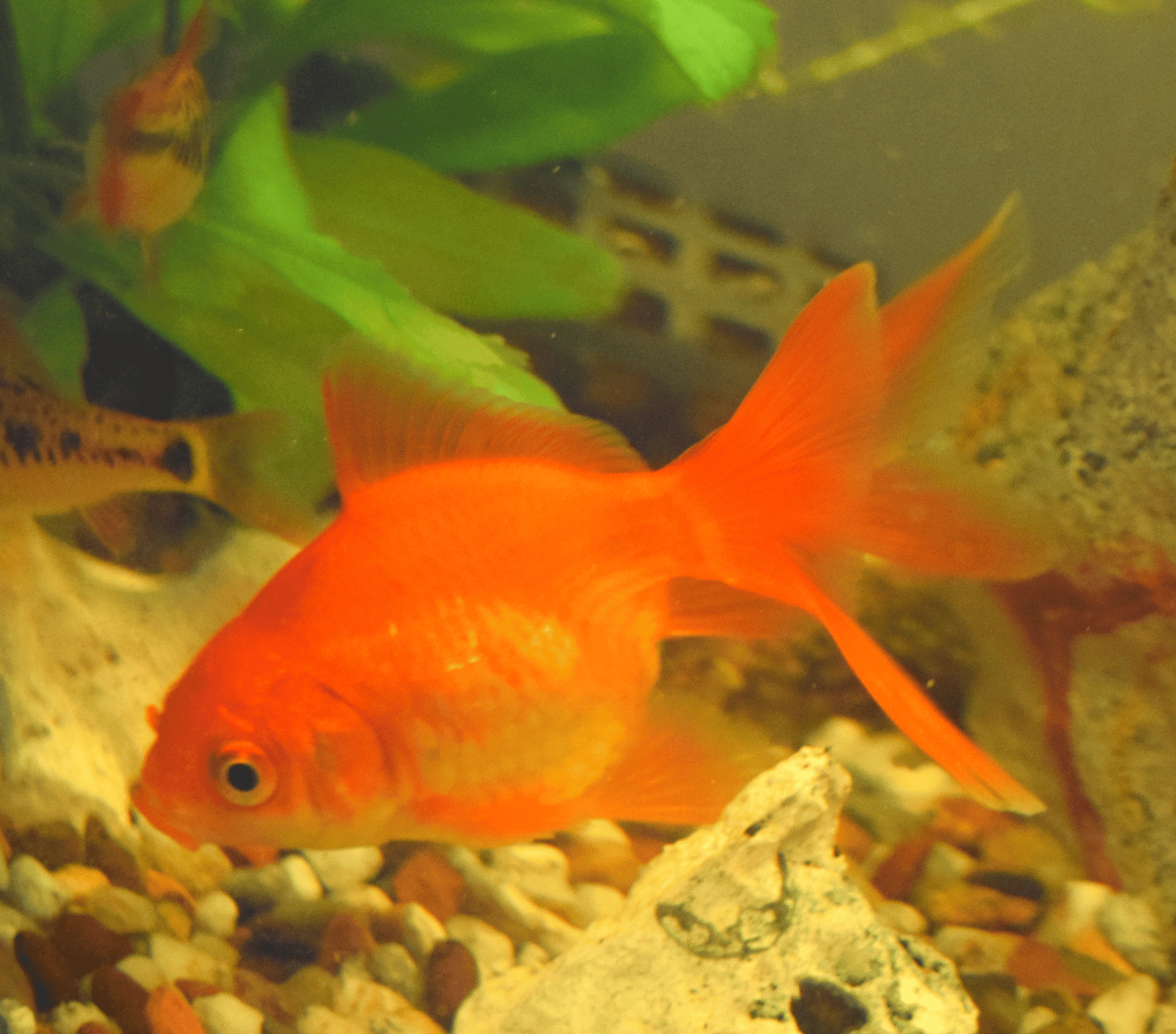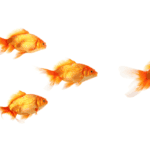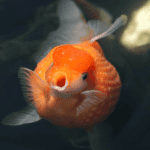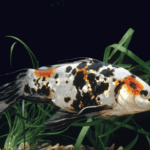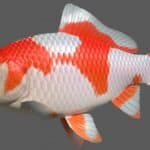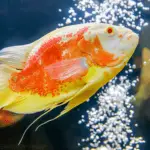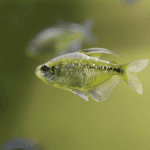Fantail Goldfish are a popular and attractive variety of fancy goldfish, known for their unique double tail feature. This breed has been specifically bred to exhibit two top and bottom caudal fins, with the upper fin fused along the top, creating a beautiful fan-like appearance. Often considered a hardy species, Fantail Goldfish make excellent pets for both beginners and experienced aquarium owners.
These coldwater fish thrive in water temperatures ranging from 65° to 72° Fahrenheit, with an ideal pH level between 6.0 and 8.0. Proper care for Fantail Goldfish also includes efficient filtration, as they produce a significant amount of waste. Offering granules as their primary food source, goldfish owners can support their Fantail’s health and longevity, which typically spans between five and ten years.
In addition to their stunning appearance, Fantail Goldfish are known for their adaptability and resilience. They can even thrive in ponds once they reach over 5 inches in length. With proper care and attention, Fantail Goldfish can bring immense beauty and enjoyment to both experienced and novice aquarists alike.
Origins and History
The Fantail goldfish, scientifically known as Carassius auratus auratus, has its origins in Asia, specifically Japan and China. It is a fancy goldfish, known for its unique double tail, which has been developed through selective breeding.
One of the early ancestors of the Fantail goldfish is the common goldfish, which was domesticated in China over 1,000 years ago. Chinese breeders started to selectively breed different varieties of goldfish to enhance specific traits.
As goldfish keeping spread to Japan, Japanese breeders further developed the Fantail goldfish, and one notable version that arose from their breeding efforts is the Ryukin Goldfish. This variety has a highly curved back and a wider caudal fin compared to the standard Fantail goldfish.
Throughout history, goldfish enthusiasts have continued breeding new types of fancy goldfish, with over 33 different types currently existing. Among these popular goldfish varieties are the common, comet, oranda, ranchu, ryukin, shubunkin, bubble eye, and of course, the Fantail goldfish.
It is believed that some of the fancy goldfish, including the Fantail goldfish, are hybrid offspring of either a common or a comet goldfish. These hybrids, along with their unique features, have made goldfish keeping an even more fascinating and diverse hobby for fish enthusiasts around the world.
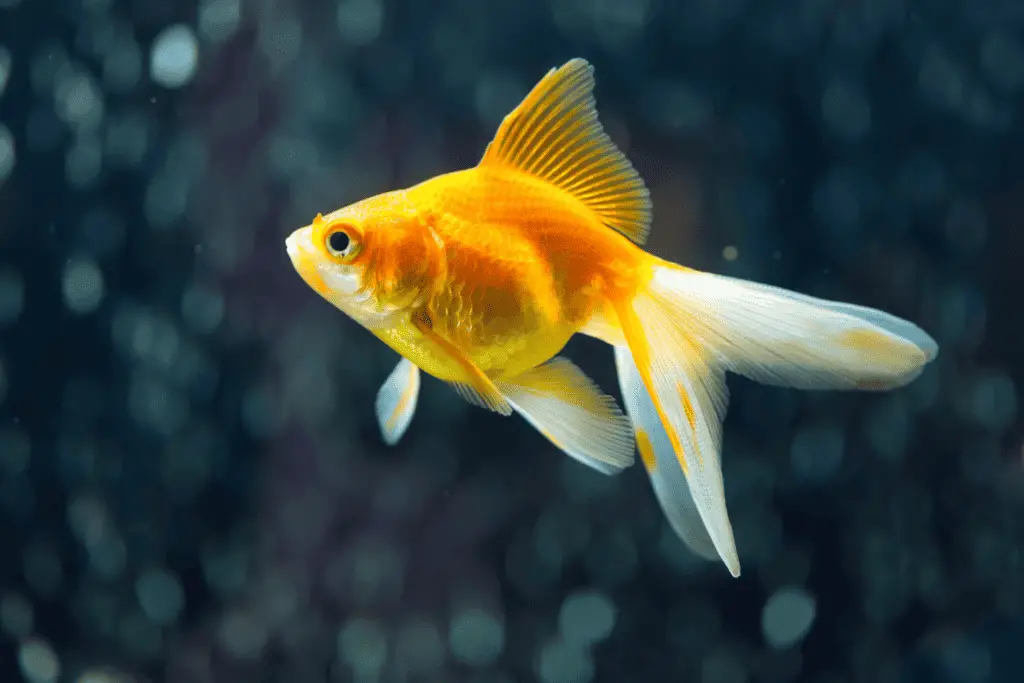
Appearance and Physical Features
Color Varieties
Fantail goldfish come in a wide variety of colors, including orange, red, white, black, and calico. Some of these fish might have a single solid color, while others might display a combination or pattern. Metallic, nacreous, and matte are the three types of scale finishes that can be observed in Fantail goldfish. These varying colors and scale finishes add to the overall charm of this species.
Fins
One noticeable feature that sets Fantail goldfish apart is their egg-shaped body. Unlike the slim, torpedo-shaped body found in common goldfish, Fantail goldfish have a bulbous, rounder shape. Their fins are long and delicate, adding to their overall appeal. The pectoral and pelvic fins are paired, and the dorsal fin is single and erect.
Tail
The Fantail goldfish’s tail is what gives this species its name. Its double caudal (tail) fin fans out when viewed from above or behind, resembling a fan or a butterfly in motion. The tail fin is forked, with lobes that are rounded or pointed. They are quite proportional to the fish’s body which makes the fish elegant in appearance. This unique tail is what makes Fantail goldfish stand out among other goldfish varieties, and it is the primary reason for its popularity among aquarium enthusiasts.
Habitat and Tank Requirements
Fantail Goldfish are freshwater fish that originate from the carp family. Their habitat in the wild consists of slow-moving or still bodies of water, such as ponds or lakes. When setting up a tank for Fantail Goldfish, it’s essential to emulate their natural environment as closely as possible.
Tank Size
- The recommended tank size for Fantail Goldfish is between 10 to 20 gallons.
- A spacious tank ensures proper growth and well-being of the fish, as well as reduces the risk of stunting or other health problems.
- Keep in mind that a larger tank is always preferable, as it provides more room for these active swimmers to move around.
Water Parameters
- Temperature: Fantail Goldfish prefer a water temperature range of 65°F to 75°F.
- pH: The ideal pH range for Fantail Goldfish is between 6.5 and 7.5.
- Hardness: They thrive in water with a hardness level of 100-250 ppm.
Creating a Suitable Environment
- Freshwater tank: Use tap water and add a conditioner to remove harmful chemicals.
- Substrate: Choose a soft substrate, such as sand or gravel, as this helps to mimic their natural habitat.
- Decorations: Add plants and rocks to the tank to provide hiding spots, and enhance the overall aesthetics of the aquarium.
- Filtration: Ensure the tank has a reliable filtration system to maintain water quality and reduce ammonia buildup.
By taking proper measures for creating a suitable environment, the Fantail Goldfish will thrive in their new home. Adhering to the recommended tank size, water parameters, and habitat requirements is crucial to maintain their health and longevity.
Diet and Feeding
Fantail Goldfish are omnivorous, meaning they eat both plant matter and meaty proteins. To ensure proper nutrition, it is essential to provide them with a balanced and varied diet. Here are some diet components to consider for your Fantail Goldfish:
Pellets and Flake Food
Feed your Fantail Goldfish high-quality pellets or flake food specifically formulated for round-bodied fancy goldfish. Their pellet food should be the appropriate size for them to swallow easily. Sinking foods are recommended over floating foods for Fantail Goldfish.
Vegetables and Fruits
Incorporate vegetables and fruit into your goldfish’s diet to provide essential nutrients and add variety. Good options include:
- Cucumbers
- Peas
- Sweet potatoes
- Carrots
- Strawberries
- Kiwi slices
- Oranges
- Applesauce
Rotate the vegetables and fruit, so your goldfish don’t get tired of any one thing.
Treats
A few times a week, you can supplement your Fantail Goldfish diet with treats like:
- Frozen or freeze-dried brine shrimp
- Daphnia
- Bloodworms
Additionally, goldfish enjoy nibbling on small pieces of veggies like lettuce, blanched peas, duckweed, or zucchini.
When feeding your Fantail Goldfish, ensure you do not overfeed them, as they have a tendency to eat anything offered. Monitor their behavior and adjust feeding quantities accordingly. Following these guidelines will help keep your Fantail Goldfish healthy and happy.
Breeding and Reproduction
Breeding fantail goldfish can be a rewarding process with proper care and preparation. The breeding process usually starts in early spring, around March, when the water temperature begins to warm up. Here are the essential steps for successfully breeding Fantail Goldfish:
- Water Temperature: Start by reducing the aquarium temperature to between 10°C (50°F) and 12°C (54°F). Then, gradually raise the temperature by 2°C (3°F) per day until it reaches 20°C (68°F) to 23°C (74°F). This simulates the natural temperature increase that occurs during spring.
- Selecting Breeding Fish: Choose one female Fantail Goldfish, usually two years old, and three males, which can be one year old. This helps ensure a higher probability of successful breeding.
- Tank Environment: Add live plants, such as Duckweed, Frogbit, Water Lettuce, and Water Hyacinth, to provide a suitable breeding environment. These plants offer hiding spots for the eggs and fry. Maintain a stable pH of 6-8.
- Water Quality: Perform weekly water changes of 10-20% to maintain optimum water quality. Monitor water conditions and ensure proper oxygen levels are present during the entire breeding process.
The actual breeding process starts when the male circles the female, initiating the spawning. The female will then scatter eggs throughout the tank on the live plants and any other available surfaces. After the eggs are fertilized by the males, it usually takes around 3-4 days for them to hatch.
It is essential to monitor the breeding process and separate the adult fish from the eggs and fry. This ensures their safety as adult goldfish might eat their own eggs or fry. Bring up the fry on a high-quality diet, such as brine shrimp and finely crushed goldfish flakes, to provide them the best nutrition for growth and development. After several weeks, the fry will begin to develop the distinct Fantail Goldfish features, and you can introduce them to the main aquarium or rehome them.
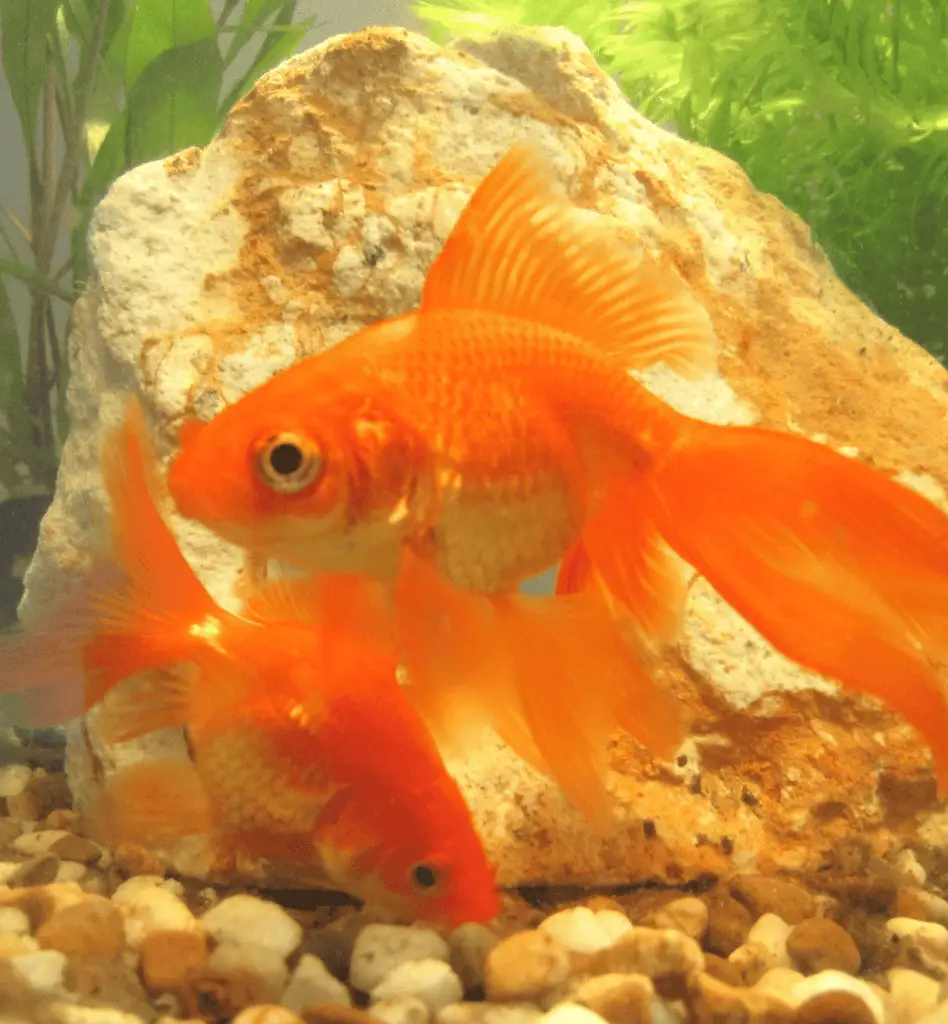
Common Health Issues
Fantail Goldfish are generally hardy and resilient creatures but can still face some health problems. In this section, we will discuss two common health issues that Fantail Goldfish are prone to experience: Swim Bladder Disease and Fin Rot.
Swim Bladder Disease
Swim Bladder Disease, which often leads to buoyancy disorders, is a common issue that affects Fantail Goldfish. Goldfish are physostomous fish, meaning they have a duct connecting their esophagus and swim bladder. They swallow air to inflate and rise in the water column.
The most common cause of swim bladder problems in Fantails and other fancy goldfish species is constipation. To treat this issue:
- Starve your fish for 24 to 48 hours
- Feed them with a fiber-rich diet like peeled, cooked peas or daphnia
Another possible cause of Swim Bladder Disease can be bacterial infections. If the problem doesn’t improve after dietary adjustments, consider consulting a fish health specialist.
Fin Rot
Fin Rot is another common disease that affects goldfish, including Fantails. It is characterized by the deterioration of the fins’ edges, which can turn ragged or discolored. Fin Rot can be caused by poor water quality, stress, or bacterial infections.
To prevent and treat Fin Rot:
- Maintain water quality: Perform regular water changes, ensure proper filtration, and keep the ammonia, nitrites, and nitrates in check.
- Reduce stress: Provide ample space, minimize disturbances, and avoid overcrowding in the tank.
- Isolate affected fish: Place the affected fish in a quarantine tank to prevent the spread of the disease to tankmates.
- Consider medications: If the problem persists, use appropriate antibacterial treatments after consulting a fish health specialist.
By being aware of these common health issues affecting Fantail Goldfish, you can better monitor their well-being and ensure they live a healthy, happy life in your aquarium.
Tank Mates
Fantail goldfish are peaceful and social fish that can make great additions to a tank, provided they are paired with suitable tank mates. Choosing the right companions for Fantail goldfish can be tricky, as they are not strong swimmers and can easily fall victim to aggressive or fin-nipping species.
The key to selecting appropriate tank mates for Fantail goldfish is to look for calm and peaceful species that are neither too small for the goldfish to prey upon, nor aggressive towards the vulnerable Fantail. Here are some ideal tank mates for Fantail goldfish:
- White Cloud Mountain minnows: These fish are well-suited to a goldfish tank environment, being fast and powerful swimmers. They can easily evade any hungry goldfish while also complementing the energy levels of fast-swimming varieties. White Cloud Mountain minnows grow up to 1.5 inches in size.
- Rosy Barbs: A good option for fancy goldfish tanks, Rosy Barbs are a larger relative of the Checkered Barb. These red to pink-colored fish can reach up to 6 inches in length and prefer to be in large schools of 10 or more. They enjoy swimming in strong currents in the middle of the aquarium.
However, it’s essential to avoid including the following types of fish as tank mates for Fantail goldfish:
- Slim-bodied goldfish and Koi: They are not good companions for Fantails, as they can outcompete the slower and weaker swimmers for food and resources.
- Tiny invertebrates and small fish: These creatures are unsuitable tank mates for Fantail goldfish as they can end up being preyed upon by the larger fish.
Remember to adjust your tank size and conditions as needed to accommodate the requirements of both the Fantail goldfish and its tank mates. By selecting compatible companions for your Fantail goldfish, you can ensure a harmonious and stress-free aquarium environment.
Life Expectancy
Fantail goldfish are a popular aquarium fish known for their unique appearance, including their double tails and short bodies. These fish generally have a lifespan of 10 to 15 years, making them a long-term commitment for aquarium enthusiasts.
One factor impacting the lifespan of a Fantail goldfish is its living environment. A tank size of 10 to 20 gallons per fish is recommended, as these goldfish are not powerful swimmers and do not require oversized tanks. Providing ample space for swimming and maintaining water quality is crucial for the health and longevity of your Fantail goldfish.
Diet is another essential aspect for the welfare and life expectancy of Fantail goldfish. Considering that they are omnivorous scavengers, a balanced diet containing both vegetarian and non-vegetarian foods is highly recommended. Typically, flakes and pellets offer adequate nutrients, but supplemental feedings of fresh vegetables and live or frozen foods can be beneficial.
Here are some tips to ensure a healthier life for your Fantail goldfish:
- Maintain optimal water quality with regular monitoring and changes.
- Provide a well-balanced diet with various food sources for proper nutrition.
- Create a stress-free environment by minimizing abrupt changes in temperature or water conditions.
- Ensure adequate filtration to remove contaminants and maintain oxygen levels in the water.
- Consider providing enrichment items, hiding spots, and live plants for your Fantail goldfish to interact with.
By following these guidelines and staying attentive to your Fantail goldfish’s needs, you can significantly increase the chances of them living a long and healthy life.
